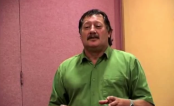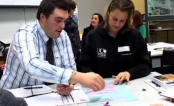Te Aho Arataki Marau mō te Ako i Te Reo Māori - Kura Auraki
Curriculum Guidelines for Teaching and Learning Te Reo Māori in English-medium Schools: Years 1-13
Curriculum guidelines 521 PDF (PDF, 4 MB)
Page navigation:
Te tirohanga takanga i te roanga atu o te wā
Changing perceptions over time

In the nineteenth century and the early twentieth century, most Māori lived in rural communities where te reo Māori was the first language and was passed on within the community. But a growing perception that English was the key to Māori progress and development led to a widespread language shift from te reo Māori to English between the 1940s and the 1970s.
This was a time of great social change for Māori, including the migration by many Māori people from rural to urban areas in search of work. Many Māori parents stopped speaking te reo Māori to their children, and at school, children were often actively discouraged from speaking te reo.
By the 1970s, there were fears that te reo Māori would be lost with the passing of the contemporary generation of Māori-speaking adults. This fear was based on a very real danger. A survey conducted by the New Zealand Council of Educational Research between 1973 and 1978 showed that only 18 to 20 percent of Māori were fluent in te reo Māori and that most of these fluent speakers were elderly. (See Benton, 1981, page 15.)
In response to this concern, groups such as the Te Reo Māori Māori Society and Ngā Tamatoa emerged to advocate for te reo Māori and to reassert their identity as Māori.
On 14 September 1972, the leaders of these organisations presented Parliament with a petition signed by over 30 000 people and calling for the provision of te reo Māori courses in schools. On the same date was New Zealand’s first Māori Language Day; in 1975, this grew to Māori Language Week.
As well as advocating for te reo Māori in the subsequent decades, Māori led a variety of initiatives aimed at recovering te reo Māori. Initially, most of these initiatives were focused on education. They included, for example, the foundation of the Kōhanga Reo and Kura Kaupapa movements.
In the 1980s, the focus widened to broadcasting (today, a network of iwi radio stations and a highly regarded Māori television channel exists). In 1987, a successful claim to the Waitangi Tribunal led to te reo Māori being declared an official language and to the creation of Te Taura Whiri i te Reo Māori. In consequence, a range of other programmes and initiatives have been developed.
Surveys reveal this work is bearing fruit and that the language has been stabilised. About 24 percent of the Māori population (approximately 130 000 people) are now able to speak with some proficiency in te reo Māori, and there are 30 000 Pākehā who speak te reo Māori with varying degrees of proficiency.2
The government’s Māori Language Strategy, initiated in 2003, is intended to build on this foundation. Its goals include ensuring that, by 2028, the majority of Māori will have some proficiency in te reo Māori and all New Zealanders will appreciate its value to New Zealand society. Ka Hikitia – Accelerating Success 2013 -2017 (Te Tāhuhu o te Matauranga/Ministry of Education, 2013) prioritises Māori language education as one of its four focus areas for change in the education system.
Today, The New Zealand Curriculum and Ka Hikitia affirm the value of te reo Māori as the indigenous language of New Zealand. Increasingly, New Zealanders understand that te reo Māori and tikanga Māori are essential components of this country’s heritage. While they define Māori identity in particular, they are integral to the identity of all New Zealanders.
This vibrant language supports the development and celebration of our national identity, enhances the mana whenua of our indigenous people and contributes to a creative and successful economy.
Ka Hikitia, p.25
Yet for all the positive indications of change, only three-percent of New Zealanders can actually converse in te reo Māori.
If this is to change, all schools will need to provide their students with the opportunities to learn te reo Māori that are available through The New Zealand Curriculum.
Te reo Māori
Ko te reo te manawapou o te iwi
Mā te kōrero
Te reo e ora ai
Mā te ora o te reo
Ka rangatira 3… All students must be able to access quality Māori language education options across
the education sector if they so choose.Ka Hikitia, p.24
The New Zealand Curriculum (see below) emphasises the value of te reo Māori and explains how learning te reo will benefit our young people.
Te reo Māori
Ko te reo te manawa pou o te Māori,
Ko te ihi te waimanawa o te tangata,
Ko te roimata, ko te hūpē te waiaroha.
Ko tōku nui, tōku wehi, tōku whakatiketike, tōku reo.4Te reo Māori is indigenous to Aotearoa New Zealand. It is a taonga recognised under the Treaty of Waitangi, a primary source of our nation’s self-knowledge and identity, and an official language. By understanding and using te reo Māori, New Zealanders become more aware of the role played by the indigenous language and culture in defining and asserting our point of difference in the wider world.
Ko te reo Māori te kākahu o te whakaaro,
te huarahi i te ao tūroa.5By learning te reo and becoming increasingly familiar with tikanga, Māori students strengthen their identities, while non-Māori journey towards shared cultural understandings. All who learn te reo Māori help to secure its future as a living, dynamic and rich language. As they learn, they come to appreciate that diversity is a key to unity.
Te reo Māori underpins Māori cultural development and supports Māori social and economic development in Aotearoa New Zealand and internationally. Understanding te reo Māori stretches learners cognitively, enabling them to think in different ways and preparing them for leadership.
By learning te reo Māori, students are able to:
- participate with understanding and confidence in situations where te reo and tikanga Māori predominate and to integrate language and cultural understandings into their lives
- strengthen Aotearoa New Zealand’s identity in the world
- broaden their entrepreneurial and employment options to include work in an ever-increasing range of social, legal, educational, business and professional settings.
Ko te manu e kai ana i te miro, nōna te ngahere.
Ko te manu e kai ana i te mātauranga, nōna te ao.
Ko te reo te mauri o te mana Māori.6The New Zealand Curriculum, p.14
Footnotes
2 Source: Statistics New Zealand (2001).
3 See Acknowledgment and translations for an English translation.
4 See Acknowledgment and translations for an English translation.
5 See Acknowledgment and translations for an English translation.
6 See Acknowledgment and translations for an English translation.





